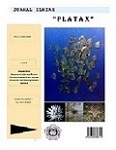Effectiveness of rearing Sandfish, Holothuria scabra and Seaweed, Gracilaria sp. with the Polyculture System
DOI:
https://doi.org/10.35800/jip.7.1.2019.23373Abstract
Sandfish (Holothurai scabra) and seaweed Gracilaria sp are marine commodities that have economic value and have good prospects in the market. These two commodities, if rearing together, will certainly provide added value to farmers. This research aims to determine the potential of sea cucumber polyculture, (H. scabra) and Gracilaria sp. which is maintained in culture. This research was conducted in April - May 2018 in the coastal of Rat village, Southeast Maluku Regency. Sea cucumbers are weighed and stocked on Pen-culture (measuring 4 x 3 meters) with a density of 40 individuals / Pen-culture. Gracilaria seeds are taken from young thallus which are tied into one clump and ditagging. After that, Gracilaria was weighed and spread in Pen-culture of 20 clump / Pen-culture. Observation of growth and survival of sandfish and Gracilaria sp done once a week. At the same time, predator control is carried out on pen-culture and water quality measurements. The results showed that sea cucumbers experienced absolute growth and survival rates of 18.20 g and 92.5% respectively. Gracilaria sp which is maintained does not experience growth, while the percentage of survival of Gracilaria sp is 20%. Based on the results of the research it can be concluded that Polyculture of sandfish, H. scaba and seaweed, Gracilria sp is not effective if Gracilria sp is stocked on the basis of Pen-culture.
Keyword : Sandfish, Gracilaria, Polyculture
ABSTRAK
Teripang pasir (Holothurai scabra) dan rumput laut Gracilaria sp merupakan komuditi laut yang bernilai ekonomis dan mempunyai prospek yang baik dipasaran. Kedua komuditi ini, jika dipelihara bersama tentunya akan memberikan nilai tambah bagi pembudidaya. Penelitian ini bertujuan untuk mengetahui potensi polikultur teripang pasir, (H. scabra) dan Gracilaria sp. yang dipelihara pada pen-culture.
Penelitian ini dilaksanakan pada bulan April – Mei 2018 di perairan desa Rat, Kabupaten Maluku Tenggara. Teripang pasir ditimbang dan ditebar pada Pen-culture berukuran 4 x 3 meter dengan kepadatan 40 individu/Pen-culture. Bibit Gracilaria diambil dari thallus muda yang diikat menjadi satu rumpun dan ditagging. Setelah itu, Gracilaria ditimbang dan ditebar pada Pen-culture sebanyak 20 rumpun/ Pen-culture.
Pengamatan pertumbuhan dan kelangsungan hidup teripang pasir dan Gracilaria sp. dilakukan seminggu sekali. Pada waktu yang bersamaan, dilakukan juga pengontrolan predator pada Pen-culture dan pengukuran kualitas air. Hasil penelitian diketahui bahwa teripang mengalami rata-rata pertumbuhan mutlak dan kelangsungan hidup, masing-masing sebesar 18.20 g dan 92.5 %. Gracilaria sp yang dipelihara tidak mengalami pertumbuhan, sedangkan presentase kelangungan hidup Gracilaria sp sebesar 20 %. Berdasarkan hasil penelitian dapat disimpulkan bahwa Polikultur teripang pasir, H. scaba dan rumput laut, Gracilria sp tidak efektif jika Gracilria sp ditebar pada dasar Pen-culture.Â
Kata kunci : Teripang pasir, Gracilaria, Polikultur
Downloads
Published
How to Cite
Issue
Section
License
COPYRIGHT
Authors who publish with this journal agree to the following terms:
Authors hold their copyright and grant this journal the privilege of first publication, with the work simultaneously licensed under a Creative Commons Attribution License that permits others to impart the work with an acknowledgment of the work's origin and initial publication by this journal.
Authors can enter into separate or additional contractual arrangements for the non-exclusive distribution of the journal's published version of the work (for example, post it to an institutional repository or publish it in a book), with an acknowledgment of its underlying publication in this journal.
Authors are permitted and encouraged to post their work online (for example, in institutional repositories or on their website) as it can lead to productive exchanges, as well as earlier and greater citation of the published work (See The Effect of Open Access).




















